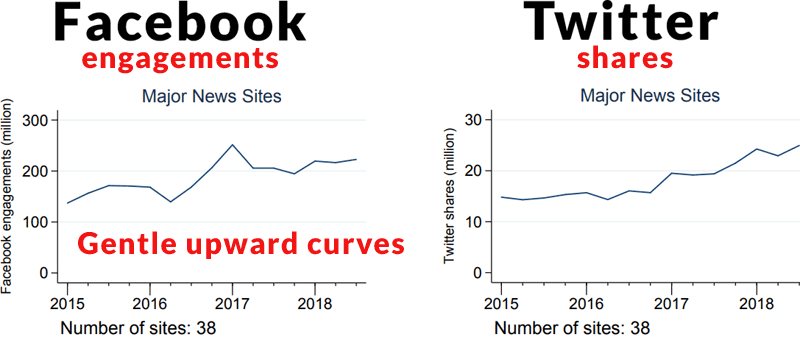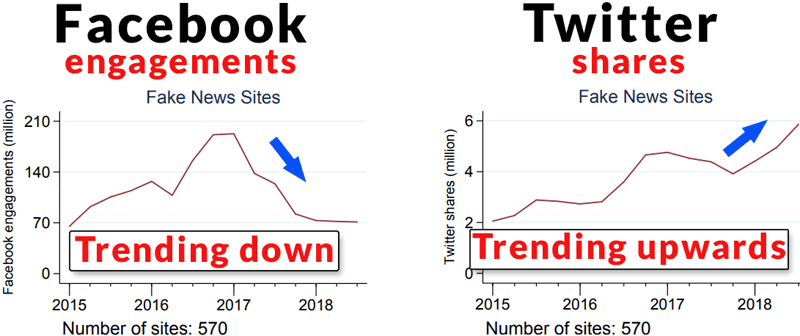Facebook recently announced it is making strides against fake news. It cited several studies that independently concluded Facebook has dramatically decreased the reach of fake news by high percentages. But percentages don’t tell the whole story.
Facebook has indeed made great strides, as you will see below. Yet when you look at the numbers instead of percentages, a study reveals that fake news engagement on Facebook as of July 2018 was 70 million per month.
What’s going on at Twitter is another story.
Since the 2016 US Election, Facebook has announced twelve spam crackdowns while Twitter only announced five. The research shows that Twitter’s fight is not going so well.
According to Facebook:
As these studies attest, we’ve invested heavily in our strategy to fight misinformation since the 2016 US elections. We continue to roll out updates that address some of the outstanding gaps mentioned in these studies.
Methodology
Lists of Fake News Sites
The study authors gathered lists of fake news sites as published by various sites and researchers, including the following:
- Politifact
- FactCheck
- Snopes
- BuzzFeed
- European Research Council paper
Share and Engagement Metrics
Facebook engagement and Twitter share metrics were collected from BuzzSumo.
Comparison with Real News Sites
The researchers also compiled a list of legitimate news websites, as well as sites from the arts, business, sports and other niches.
Results of Research Study
News sites displayed an upward trend on both Twitter and Facebook. The trend on Facebook is clearly because of the changes in the news feed to emphasize news, especially local news.

Fake News Trends
Fake news sites increased on Facebook and Twitter leading up to he 2016 election. After the election, engagement rates plummeted by 50% on Facebook while Twitter shares kept rising.

Facebook Engagement versus Twitter Shares
According to the research study:
“Facebook engagements fell from a peak of roughly 200 million per month at the end of 2016 to roughly 70 million per month at the end of our sample period.
As a point of comparison, the 38 major news sites… including the New York Times, Wall Street Journal, CNN, Fox News, etc.—typically garner about 200-250 million Facebook engagements per month.”
As you can see, Facebook’s metrics for fighting fake news are superior to Twitter’s. However, as of the end of the study in July 2018, Facebook was still serving up 70 million engagements with fake news per month.
The reach of fake news on Facebook is equal to 35% of all legitimate news websites combined. That’s a staggering amount of fake news that is still circulating on Facebook.
Facebook has announced several more spam crackdowns that affected fake news sites since the release of this study. So the amount of fake news reaching Facebook members today is quite likely less than the 35% reported by this study.
Is Making Strides Against Fake News Enough?
The results are clear. Facebook is making strides in the fight against fake news. Twitter is achieving less success and taking less actions taken against fake news.
Yet with 70 million people engaging with fake news as of July 2018, Facebook still has more battles to fight.
Read the research study published at Stanford and discover the citations:
Trends in the Diffusion of Misinformation on Social Media
Read Facebook’s announcement here.
Images by Shutterstock, Modified by Author
Screenshots by Author, Modified by Author





